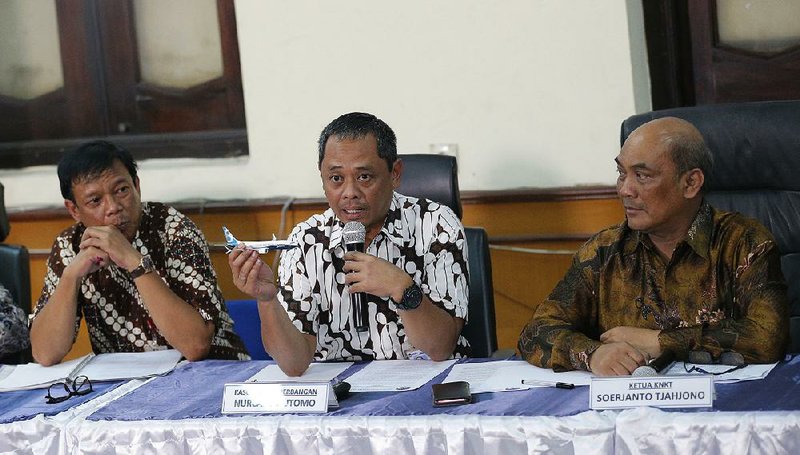JAKARTA, Indonesia -- Design flaws in Boeing's 737 Max jet, regulatory lapses and false assumptions about pilots' responses to new systems combined to cause last year's fatal Lion Air crash, Indonesian investigators said Friday, as they released a final report that pinpointed faults in a flight-control feature intended to prevent the aircraft from stalling.
The crash prompted Boeing to make changes to the 737 Max, the manufacturer said in a statement Friday as the report was released. The fixes included changing how the angle-of-attack sensors feed information to the cockpit and improving crew manuals and pilot training.
"These software changes will prevent the flight control conditions that occurred in this accident from ever happening again," Boeing said.
Lion Air Flight 610 crashed into the Java Sea on Oct. 29, shortly after taking off from Jakarta. All eight crew members and 181 passengers were killed.
[Video not showing up above? Click here to watch » https://www.youtube.com/watch?v=Xw8YvYE9G_k]
The crash was soon tied to a new automated feature that Boeing had included on the 737 Max, a new version of its popular jet with larger, more fuel-efficient engines. Investigators say the feature was mistakenly triggered by faulty information from an external sensor.
Similar problems were blamed for the crash of an Ethiopian Airlines flight in March that killed 157 people. The Max has been grounded worldwide since shortly after that crash.
On Friday, officials from Indonesia's transportation safety regulator said nine factors worked together to doom the Lion Air jet.
"These items were connected to each other. If one of them was not occurring on that day, the accident may not have happened," said Nurcahyo Utomo, an investigator at the National Transportation Safety Committee.
Those factors included incorrect assumptions by Boeing about how pilots would respond to the new flight-control system, known as the Maneuvering Characteristics Augmentation System. Investigators highlighted how the system's design relied on a single sensor and was therefore vulnerable to errors.
"One [angle of attack] affected the whole system," Nurcahyo said. A false reading on that sensor redirected the plane's nose downward, leaving the cockpit crew unable to override the autopilot commands.
Other fatal mistakes included a lack of training for pilots in the new system, a lack of documentation about problems in previous Lion Air flights involving the same jet and ineffective coordination between flight crews. Investigators concluded that the plane should have been grounded after an earlier fault.
The report offered stark new details on the back story of an external sensor involved in the crash, pointing at the role of a maintenance firm in Florida and oversight by U.S. regulators.
A dirty angle-of-attack sensor was sent to a Miramar-based company, Xtra Aerospace, for maintenance in 2017. It was then sent back and installed on the left side of the Lion Air flight the day before it plunged into the Java Sea, the report said.
Angle-of-attack sensors are supposed to give pilots, and airplane systems, reliable information to help understand how the aircraft's nose is pointed in relation to oncoming wind.
But shortly after takeoff, the newly installed left sensor showed a reading that was different, by 21 degrees, from the one on the right. Investigators say that inaccurate reading caused Boeing's automated feature to mistakenly fire, again and again, before the plane eventually crashed.
The "sensor was most likely improperly calibrated at Xtra Aerospace," the Indonesian crash report said.
The report said Xtra should have had a written procedure regarding the part of the process that may have gone wrong. The lack of such a written procedure was not detected by a relevant Federal Aviation Administration office, the report said, and "this indicates inadequacy of FAA oversight."
The agency said it issued an order revoking Xtra Aerospace's repair station certificate Friday, saying the company had "failed to comply with requirements to repair only aircraft parts on its list of parts acceptable to the FAA that it was capable of repairing."
An Xtra employee in Florida referred questions to legal counsel at corporate parent Wencor Group. An employee at Wencor would not answer questions.
The Indonesian report called for improved oversight by the Federal Aviation Administration more broadly, and changes at Boeing as well as Lion Air.
Indonesian investigators said their report was not aimed at pinpointing culpability but at ensuring passenger safety and preventing a similar accident. The report cannot be used for liability or compensation issues in court.
In a statement, Lion Air said it was essential to take "immediate corrective actions to ensure that an accident like this one never happens again."
Charles Herrmann, a Seattle attorney representing the families of 46 Lion Air crash victims, said the crash anniversary and the release of the report are "a double wounding" for his clients.
"This is a devastating experience for these people," Herrmann said. "It involves not only tremendous sorrow and grief. There's a lot of anger."
A Section on 10/26/2019
